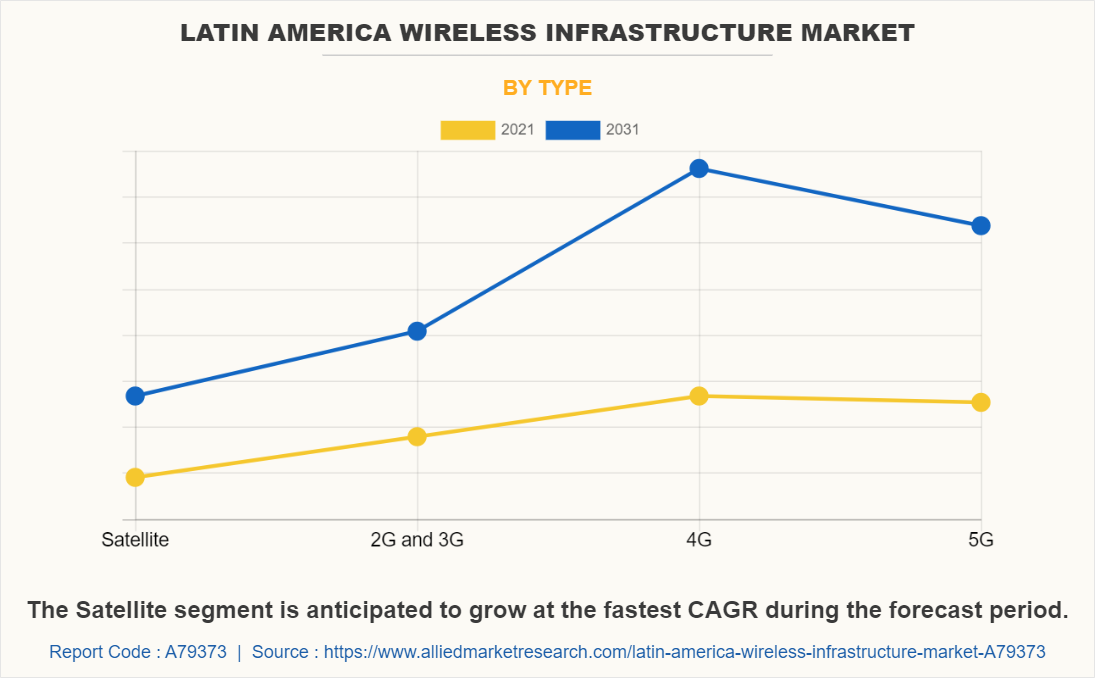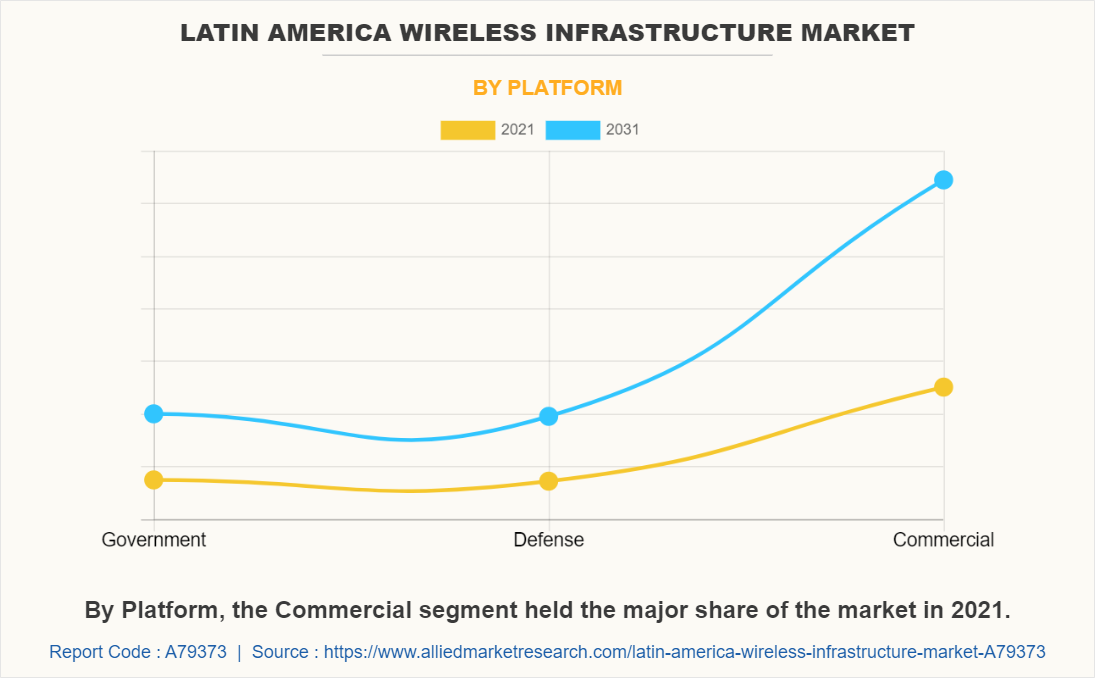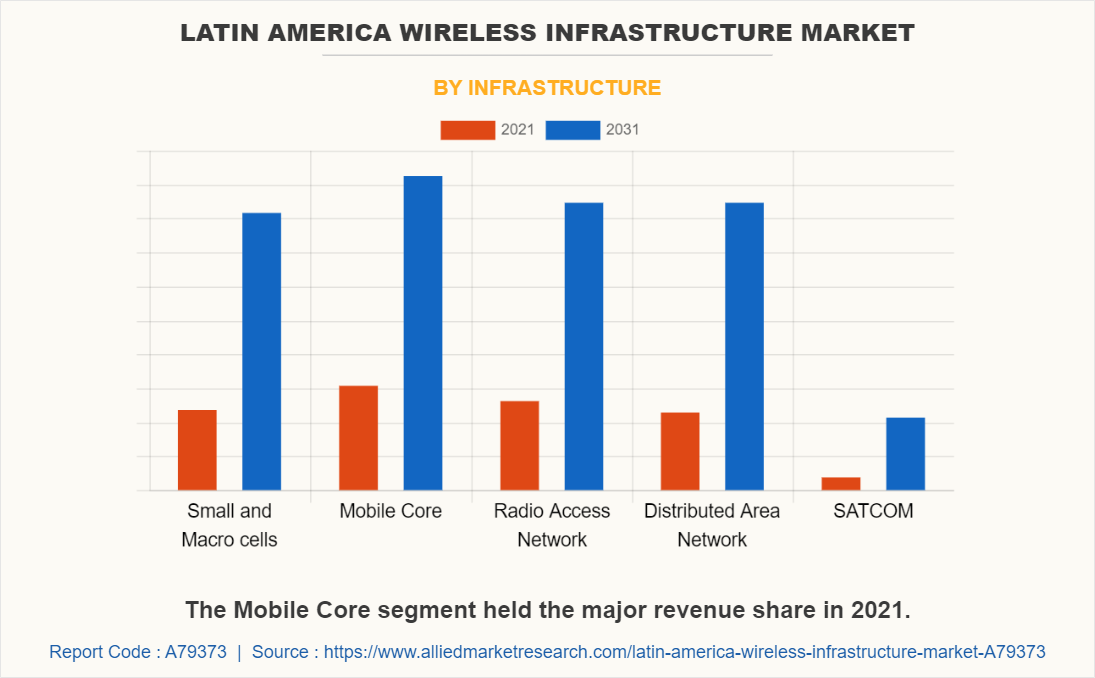The Latin America wireless infrastructure market is segmented on the basis of type, platform, and infrastructure. By type, the market is categorized into satellite, 3G, 4G, and 5G. By platform, it is segregated into government, defense, and commercial. By infrastructure, the market is divided into Small and Macro cells, Mobile Core, Radio Access Network, Distributed Area Network, and SATCOM.

Population expansion, increased adoption of smart devices, and technological integration are the key driving factors of the Latin America Wireless Infrastructure Market. Additionally, increase in government investments for 5G and 4G connectivity in the region are boosting the demand for the market. Moreover, the rise in the number of enterprises in the region associated with the communication segment is driving the market. Furthermore, the emergence of various smart city initiatives in the region that involve the deployment of wireless infrastructure is expected to enhance the market demand. And rising dependence on personal media devices such as laptops and tablets is also projected to drive the market demand.
However, high cost involved in the deployment and maintenance of wireless infrastructure is hampering the market. Moreover, stringent regulations for territorial integrity of signal data are also limiting the market growth.

The introduction of blockchain technology to reduce cyber risks associated with data transmission is projected to open several market opportunities. The increasing investments by the government in the region to support digital transformation as well as to improve network coverage are also creating numerous opportunities for the market.

Porter’s five force analysis helps to understand the competitive landscape of the market. The Bargaining Power of Buyers is high as there are numerous players operating in the market and the prices of the products are very competitive. The Bargaining Power of Suppliers is low-to-medium as the number of suppliers in the market is very competitive. The Threat of New Entrants is low-to-medium as the market has already established players and entry for the new entrants is difficult. The Threat of Substitutes is low-to-medium as the wireless infrastructure products have no direct substitutes. Lastly, the Intensity of Competitive Rivalry is high as the existing players are making attempts to gain a competitive edge over one another by offering more advanced products and services.

The Latin America wireless infrastructure market is segmented into type, platform, and infrastructure. By type, the market is categorized into satellite, 3G, 4G, and 5G. By platform, it is segregated into government, defense, and commercial. Based on the infrastructure, the market is divided into Small and Macro cells, Mobile Core, Radio Access Network, Distributed Area Network, and SATCOM.
The Latin America wireless infrastructure market is projected to witness rapid growth in the coming years, due to increasing demand for wireless infrastructure from the Latin American countries to support digitalization and expansion of telecom networks. The rising demand for seamless connectivity is further propelling market growth in the region. The rising initiatives by the government in the region to develop smart cities to improve the quality of life in urban areas are driving the market demand.
The Latin America wireless infrastructure market is expected to witness growth from the growing adoption of 5G and 4G connectivity in the region. Increased investment from abroad is expected to further boost the market growth in the coming years. The increase in demand for enhanced infrastructural development and the adoption of renewable energy are propelling the market growth in the region. The growing application of wireless infrastructure in various sectors that include defense, government, and commercial is projected to further boost the market in the upcoming years.
The leading players in the market such as Ericsson, ZTE, Huawei, Nokia, Samsung, TowerXchange, InoStairs Wireless Solutions, Cisco, Aruba Networks, and Alcatel-Lucent, have adopted several strategies over the past four years to gain a competitive edge. Ericsson, Telefonica, and Huawei have adopted partnerships and collaborations to boost their market presence. For instance, in June 2018, Huawei partnered with AT&T to improve their 5G services. Claro, Comcel, and America Movil have adopted mergers and acquisitions to expand their customer base. For example, in October 2020, America Movil acquired the Mexican telecom giant COTEK, Integrando to enhance its 5G services. Nextel International, Movistar, Nortel Networks, and ZTE Corporation have focused on the development of new products and services. For instance, in April 2021, Nortel Networks launched its 5G flexible architecture that is designed to meet the network needs of various telecom players.
New emerging companies in the market are Wytron, Sensotech, Dynamark Telecom Ventures, Versapoint, and Teramou. Wytron is a provider of wireless engineering and consulting services, Whilst Sensotech is a start-up that provides innovative wireless technologies to various sectors. Dynamark Telecom Ventures is a provider of engineering and design solutions for international telecom projects and investments. Versapoint provides complete 5G ready solutions. Lastly, Teramou offers advanced engineering solutions for the telecom sector. These companies are focused on offering innovative products and services that drive the Latin America wireless infrastructure market.
Key Benefits For Stakeholders
- Enable informed decision-making process and offer market analysis based on the current market situation and estimated future trends.
- Analyze the key strategies adopted by major market players in Latin America Wireless Infrastructure Market.
- Assess and rank the top factors that are expected to affect the growth of the Latin America Wireless Infrastructure Market.
- Top Player positioning provides a clear understanding of the present position of market players.
- Detailed analysis of the Latin America Wireless Infrastructure Market segmentation assists to determine the prevailing market opportunities.
- Identify key investment pockets for various offerings in the market.
Latin America Wireless Infrastructure Market Report Highlights
| Aspects | Details |
| Forecast period | 2021 - 2031 |
| Report Pages | 80 |
| By Type |
|
| By Platform |
|
| By Infrastructure |
|
| Key Market Players | Comcel, Ericsson, Movistar, Telefonica, Nextel International, America Movil, ZTE Corporation, Nortel Networks, Huawei, Claro |
The Latin America Wireless Infrastructure Market is estimated to reach $20.8 billion by 2031
Ericsson, Telefonica, Huawei, Claro, Comcel, America Movil, Nextel International, Movistar, Nortel Networks, ZTE Corporation are the leading players in Latin America Wireless Infrastructure Market
1. Enable informed decision-making process and offer market analysis based on current market situation and estimated future trends.
2. Analyze the key strategies adopted by major market players in latin america wireless infrastructure market.
3. Assess and rank the top factors that are expected to affect the growth of latin america wireless infrastructure market.
4. Top Player positioning provides a clear understanding of the present position of market players.
5. Detailed analysis of the latin america wireless infrastructure market segmentation assists to determine the prevailing market opportunities.
6. Identify key investment pockets for various offerings in the market.
Latin America Wireless Infrastructure Market is classified as by type, by platform, by infrastructure
Loading Table Of Content...
Loading Research Methodology...



